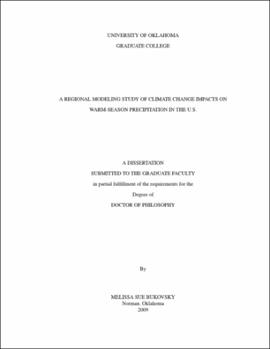| dc.contributor.advisor | Karoly, David J||Carr, Frederick H | |
| dc.creator | Bukovsky, Melissa Sue | |
| dc.date.accessioned | 2019-04-27T21:21:44Z | |
| dc.date.available | 2019-04-27T21:21:44Z | |
| dc.date.issued | 2009 | |
| dc.identifier | 99127993102042 | |
| dc.identifier.uri | https://hdl.handle.net/11244/318499 | |
| dc.description.abstract | Changes in the character of precipitation have already been observed over much of the United States. In a warming climate, the impacts of these changes will likely be felt most strongly through changes in the intensity and frequency of climate extremes. With precipitation, this has potential to be highly disruptive to the environment and the economy. However, while current global climate models may provide acceptable simulations of precipitation on a continental scale, they are lacking when it comes to properly portraying the characteristics of warm-season precipitation over the U.S., creating uncertainty in the projections of future precipitation in this area of the world. Because predicting climate change is essential for mitigation, adaptation, and planning purposes, assessing the uncertainty associated with climate change projections and producing adequate simulations of present climate is important. | |
| dc.description.abstract | This study proceeds in several parts to address this issue. It asks the overarching question of how climate change will impact warm-season precipitation over the U.S., focusing on precipitation extremes and the central U.S. region. To do so, the Weather Research and Forecasting (WRF) model is employed as a nested regional climate model to dynamically downscale output from the National Center for Atmospheric Research's (NCAR) Community Climate System Model (CCSM) version 3 and the National Center for Environmental Prediction (NCEP)/NCAR global reanalysis (NNRP). The latter is used for verification of late 20th century climate simulations from the WRF. In theory, the increase in horizontal resolution and sophistication of physical parameterizations in the WRF should improve the simulation of warm-season precipitation over the U.S., allowing a better representation of present climate and more reliable projections of future climate. As background, warm-season precipitation over the U.S. from current global climate models is assessed, as well as precipitation from current reanalyses in order to provide a basis for the comparison of model precipitation of the late 20th century. | |
| dc.description.abstract | This study finds that the WRF is able to produce precipitation that is more realistic than that from the sources of its forcing (the CCSM and NNRP). It also diagnoses potential issues with and differences between all of the simulations completed. Specifically, the magnitude of heavy 6h average precipitation events and the frequency distribution of precipitation over the central U.S. is greatly improved. Projections from the WRF for late 21st century precipitation show decreases in average May-August (MJJA) precipitation, but an increase in the intensity of both heavy precipitation events and rain in general when it does fall. A decrease in the number of 6h periods with rainfall accounts for the overall decrease in average precipitation. The WRF also shows an increase in the frequency of very heavy to extreme 6h average events, but a decrease in the frequency of all events lighter than those over the central U.S. Overall, projections from this study suggest an increase in the frequency of both floods and droughts during the warm-season in the central U.S. | |
| dc.format.extent | 146 pages | |
| dc.format.medium | application.pdf | |
| dc.language | en_US | |
| dc.relation.requires | Adobe Acrobat Reader | |
| dc.subject | Climatic changes--Forecasting--United States | |
| dc.subject | Precipitation forecasting--United States | |
| dc.subject | Global warming | |
| dc.subject | Weather forecasting--Mathematical models | |
| dc.title | A Regional Modeling Study Of Climate Change Impacts On Warm-Season Precipitation In The U.S. | |
| dc.type | text | |
| dc.type | document | |
| dc.thesis.degree | Ph.D. | |
| ou.group | College of Atmospheric & Geographic Sciences::School of Meteorology | |
